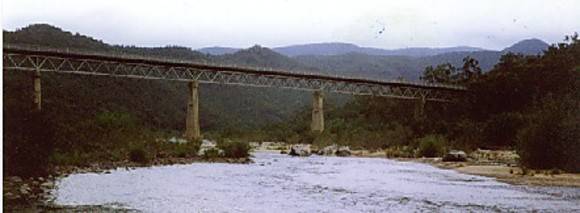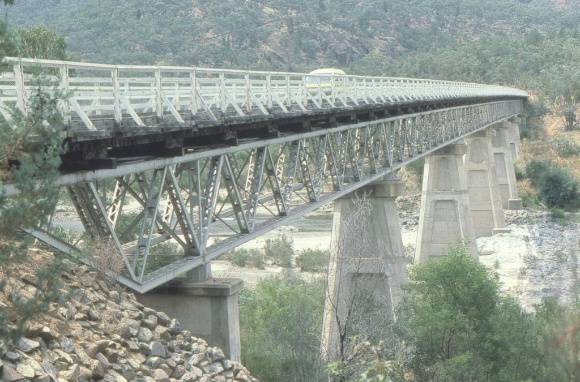| Back to search results » | Back to search page » |
|
Mckillops Bridge
LocationMcKillops Road,, DEDDICK VALLEY VIC 3888 - Property No B6848
File NumberB6848LevelState |
|
Statement of Significance
Completed in 1936 to replace its predecessor destroyed by a freak flood before it could be officially opened, McKillops Bridge is significant at State level for historical, scientific, social and aesthetic reasons. In the 1930s it was regarded as one of the standing wonders of Australian road-bridge engineering. The bridge site is in a magnificent Alpine river-gorge setting.
McKillops Bridge is based on welded-steel trusses seated on tall one-piece reinforced-concrete piers. However, the concrete and steel substructure supports an unusually long and elaborate timber stockbridge superstructure. That traditional timber superstructure seated on timber cross beams above the trusses contains shaped corbels, square-timbered stringers, spiking planks, transverse-timber decking, gravel beams, and side rails with angled timber stays. The deck is 255 metres long and 4.5 metres wide.
When constructed during the Great Depression of the 1930s, McKillops Bridge was at the leading edge of world technology with its lengthy arc-welded steel trusses, and was claimed by its builders to be the longest welded-steel-truss road bridge in the world. The arc-welding technique used in building the steel trusses that provided the load-bearing skeleton of the bridge was claimed to be in advance of equivalent British technology at the time, and was watched with interest by American engineers.
However, McKillops Bridge is a paradoxical structure, combining "the latest" in twentieth-century concrete and welded-steel technology with a handsome all-timber stock-bridge superstructure of a type that had been built in the colony of Victoria when Queen Victoria was in her prime.
It is also worthy of preservation as a magnificent example of a traditional Victorian large timber stockbridge and horse-vehicle superstructure, as for its once-trendy welded-steel-truss and concrete substructure.
Taking the name of the pioneer overlanding squatter George McKillop, who first came this way in 1835, this bridge was built largely to allow the easy passage of livestock across the high country and between New South Wales and Victoria. The site at which the bridge is built had been used as a stock crossing for almost a century before the bridge was completed, and had long been the home of the famous "turnback" government-subsidized ferry. Many of the livestock that had been used to open up vast tracts of the Port Phillip District for pastoral occupation, had come this way from the high Monaro of New South Wales.
Both the site and the main function of this bridge when it was first built, reflect the long and important pastoral history of the Port Phillip District of New South Wales, of the colony of Victoria, and of the early decades of this century when the catchments of the Upper Snowy River were being opened up for closer settlement largely through the instrumentality of the Country Roads Board. McKillop's road over McKillop's Bridge represented the very essence of between-wars Developmental Road theory, being built through remote and unpopulated forest lands to encourage future rural settlement.
The Snowy River and its rugged terrain have long provided core material for Australian balladry, folk-legend and mythology. This mythology is of the essence of our traditional cultural heritage. McKillops Bridge and the twisting mountain roads that meet there provide a means whereby ordinary Victorian motorists can appreciate at first hand the landscape that lies behind the legend, and appreciate something of the awe felt by pioneer pastoralists picking their way through the mountain passes.
In terms of visual spectacle, this combination of the old and new in bridge technology with its impressive long timber stock-bridge superstructure, viewed against a panoramic backdrop of rugged mountain forest, must rate very highly on any aesthetic scale. The timber bridge deck perched high over a mountain gorge also provides a wonderful vantage point from which to appreciate the sprawling high-country environment around the junction of the Deddick and the Snowy Rivers.
Classified: 06/11/1998
Group
Transport - Road
Category
Road Bridge





